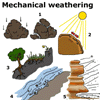Look around at the landscape in your area. Whether you see mountains, plains, river valleys, coasts, islands, lakes or ocean, what you see is the product of the constant changing of the Earth's surface.
 Mountains
are pushed up from the plains. Islands form. New land is created by volcanic
action, caused by the collision of tectonic plates and by the uplift of
shallow sea beds. Over thousands and millions of years, the twin processes
of weathering and erosion will flatten the mountains, extend the plains
and wash the highest peaks back to the ocean floor.
Mountains
are pushed up from the plains. Islands form. New land is created by volcanic
action, caused by the collision of tectonic plates and by the uplift of
shallow sea beds. Over thousands and millions of years, the twin processes
of weathering and erosion will flatten the mountains, extend the plains
and wash the highest peaks back to the ocean floor.
This topic investigates the two forms of weathering and how they help change the surface of the Earth.
What is weathering?
![]() Weathering
is the constant wearing away and the decomposition of the Earth's surface.
Rain, wind, ice, plants, animals, the temperature and chemicals all play
a part in breaking down the rocks into smaller particles which form the
basis of soil.
Weathering
is the constant wearing away and the decomposition of the Earth's surface.
Rain, wind, ice, plants, animals, the temperature and chemicals all play
a part in breaking down the rocks into smaller particles which form the
basis of soil.
There are two categories of weathering; mechanical weathering and chemical weathering. Each involves different mechanism of weathering.
 Mechanical
weathering
Mechanical
weathering
Mechanical weathering involves the breakdown of rock
to smaller pieces by mechanical or physical means. The main types of mechanical
weathering are:
- Ice wedging - If the air temperature
drops below the freezing point of water, any water caught in a crack
in a rock will expand upon freezing. This can cause the rock to crack
even more and can even break off large chunks of rock starting the process
of erosion.
- Temperature change - The Sun warming
up the surface of a rock will make the rock's surface expand. The underlying
rock remains cold and does not expand. At this point, the surface rock
may split from the underlying rock, making it vulnerable to further
weathering and erosion.
- Plants and animals - The growth of plant
roots in cracks in the rock and animals burrowing around the rocks,
allows water to enter the rock and it surrounds again making the rock
vulnerable to further weathering and erosion. Both these processes accelerate
the breakdown of rock surfaces.
- Water - Rivers and streams carrying
small rocks and mud act as abrasives on rock surfaces, wearing away
the rocks in their path.
- Wind - Wind carries sand which can impact surface rocks and sand blast them forming more sand and dust.
 Chemical
weathering
Chemical
weathering
Changes in the chemical composition of a rock will often weaken
it structurally, making it more vulnerable to mechanical weathering. Chemical
weathering occurs when air, water or acids react with rock to change its
chemical composition. The main types of chemical weathering are:
- Water - Rain falling on a new rock surface
will remove some elements from the minerals forming the rock. This process,
known as "leaching", can dramatically alter surface rock,
allowing it to become more prone to mechanical weathering.
- Oxidation - Iron left out in the weather
soon rusts. Other elements within the rock minerals will also react
with oxygen in the air, quite often forming water-soluble minerals that
can then leach away.
- Carbonation - Rainwater combines with
carbon dioxide in the air to form a weak acid known as carbonic acid.
This acidic solution is particularly effective in weathering limestone
and marble. Some limestone caves and sinkholes are thought to have been
formed by the constant action of carbonation over thousands and millions
of years.
- Plant acids - Some plants and fungi
produce acids that dissolve the surface of rocks and minerals to help
their roots gain a hold in the rock.
- Acid rain - Acid rain has been a part of the environment for about 4.5 billion years. Before the industrial age, it was a result of the interaction between sulfur from volcanoes and water in the atmosphere and in rivers and oceans. The industrial age has brought with it an increase of acid rain, now produced by sulfur dioxide being released when coal and oils are burnt. Acid rain can be a very strong acid, killing fish and accelerating the destruction of man made monuments and rock alike. The strong acids dissolve elements from minerals in the rock, altering the surface of the rock in much the same way as has been described in points 1, 2 and 4.
| Copyright owned by the State of Victoria (Department of Education and Early Childhood Development). Used with Permission. |
|
|||||||||||||||||||||||||||||||||||||||||||||||||||||||||||||||||||||||||||||||||||||